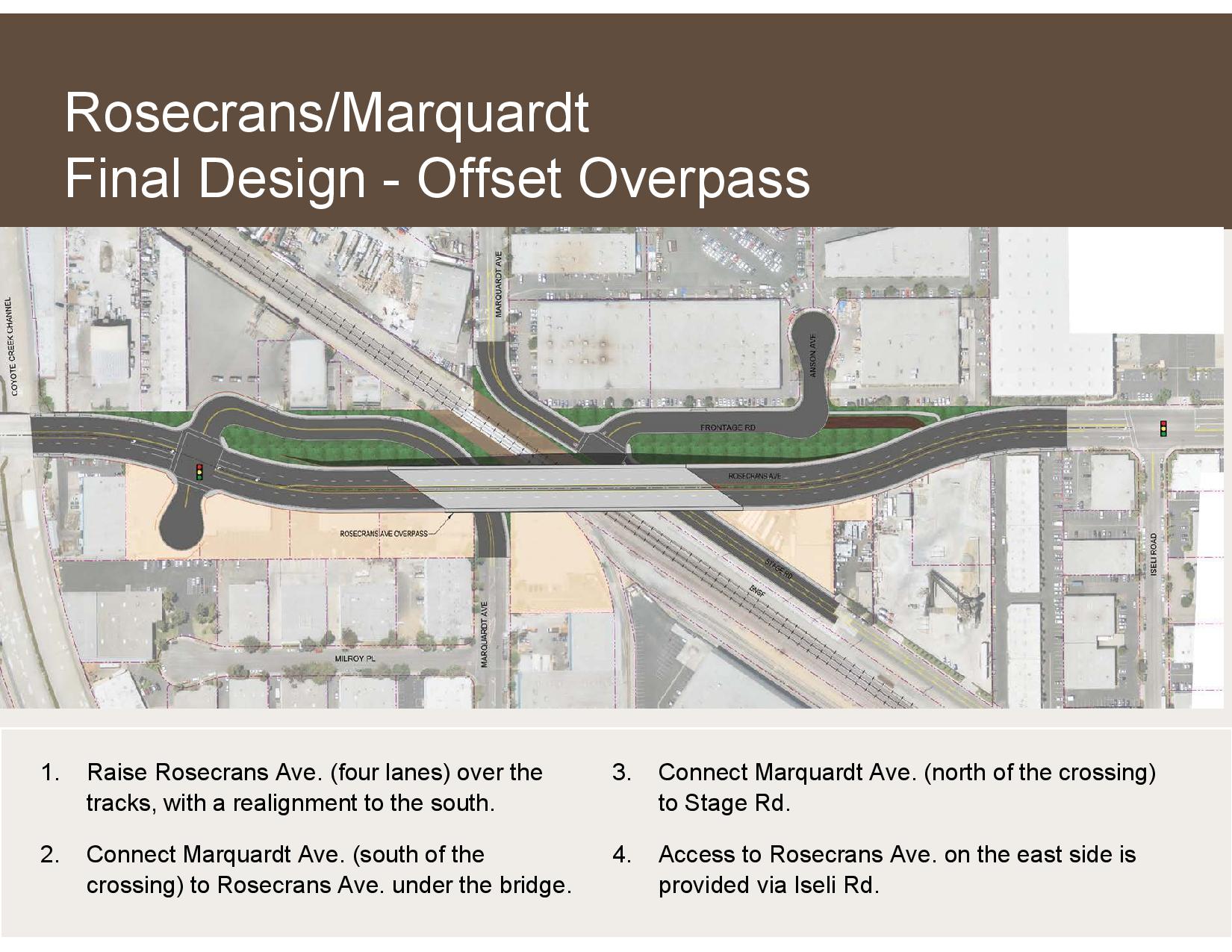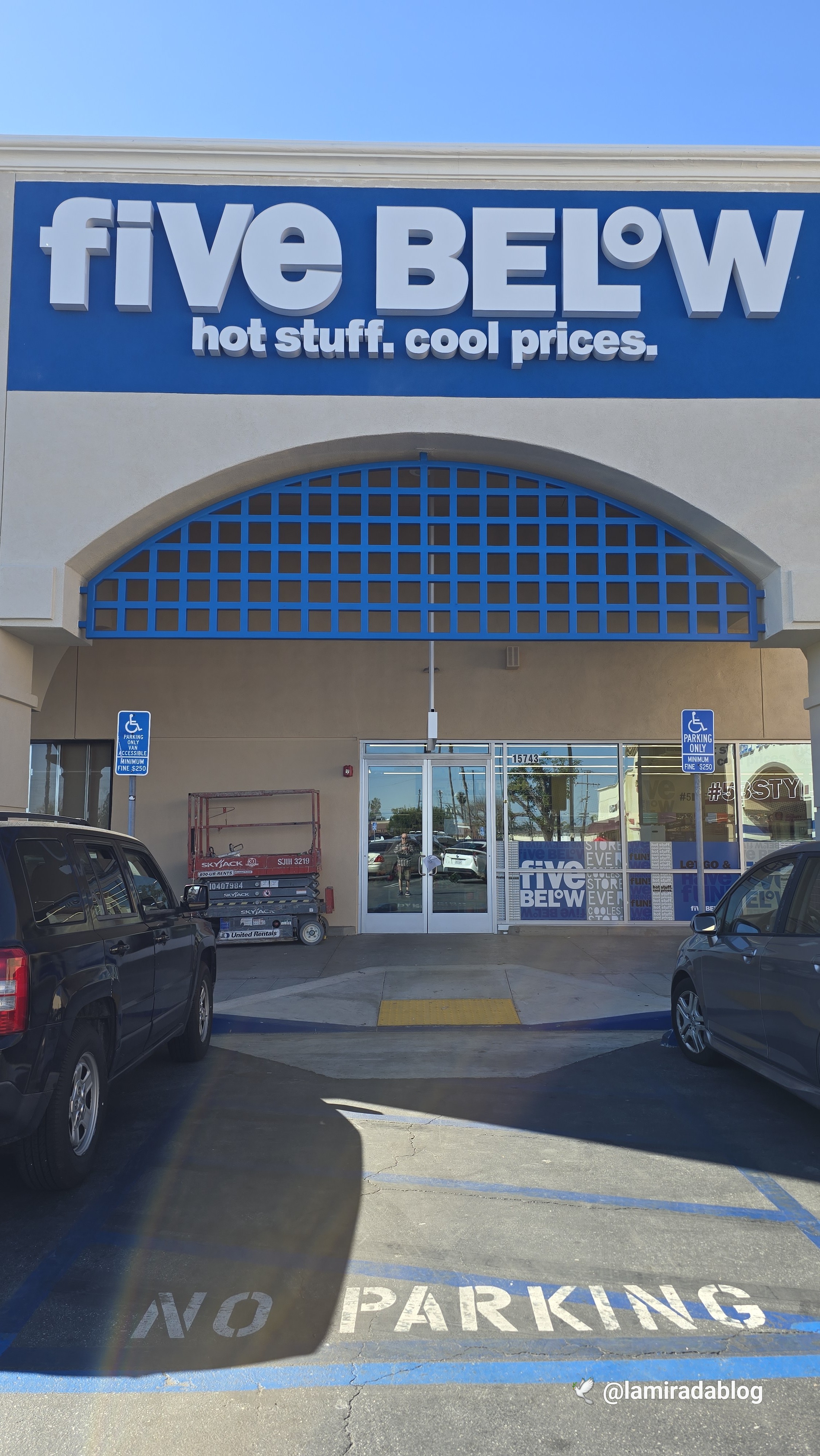Project completion is expected in mid-2025; West La Mirada residents will access Rosecrans in a different way
It’s officially the worst at-grade rail and road crossing in the state: a rail line cutting diagonally across a busy intersection in Santa Fe Springs just steps from the La Mirada border in the midst of L.A. County’s industrial heartland.
An estimated 45,000 vehicles and 135 trains travel through the intersection of Rosecrans and Marquardt Avenues in Santa Fe Springs each day-an average of one train crossing every seven minutes. As a result, vehicular traffic on both busy streets is brought to a standstill for a total of 21 hours per week.
Even worse, from 2013 to 2019, the California Public Utilities Commission recorded 31 rail-motor vehicle incidents at the intersection resulting in six fatalities and seven injuries–the most hazardous rail-motor intersection in the state.
But now, after more than a decade of effort, a fix is finally under way: a $156 million overpass project that broke ground recently and is expected to be completed in

mid-2025. The project involves construction of a bridge for Rosecrans Avenue and a set of connector roads to allow vehicles traveling on Marquardt to get to the other side of the railroad tracks.
Flatiron Construction, a subsidiary of Essen, Germany-based construction giant Hochtief, is the general contractor on the project.
“Grade separations are critical in enhancing railroad, vehicle and pedestrian safety. Plus this improvement will mitigate traffic congestion,” said Vice President & District Manager Ural Yal. “Flatiron is proud to partner with LA Metro on this important project and provide much-anticipated safety improvements to the community as quickly as possible.”
To expedite construction, Flatiron will construct the entire bridge offsite using precast girders and deck panels. Once complete, the bridge will be set into place. Building the bridge offsite will result in less congestion and a reduction in pollution related to project vehicles in the work area. With vehicular and rail traffic separated, delays will be reduced overall, while the passenger and freight trains that jointly use the tracks should flow unimpeded.
“This project presents a win-win situation for our freight and transit partners,” Stephanie Wiggins, chief executive of the Los Angeles County Metropolitan Transportation Authority, or Metro, said in the groundbreaking announcement. “We know that time is money; therefore we must do all we can to ensure that our rail crossings are not an impediment to delivering people and freight safely to their destinations,” she added.
The rail line serves freight traffic for Fort Worth, Texas-based Burlington Northern Santa Fe (BNSF) Railway Co., as well as passenger rail service under the jurisdiction of the LOSSAN Rail Corridor Agency, which is a joint-powers authority formed in 1989 to increase ridership on the coastal rail line between San Diego, Los Angeles, and San Luis Obispo.
Much of the vehicular traffic that traverses Rosecrans and Marquardt Avenues is tied to the logistics industry, moving goods to and from local warehouses and manufacturing plants.
A grade-separation project for the intersection was first proposed 20 years ago and Metro even cleared some environmental hurdles for the plan, which at the time was part of a larger set of rail improvement projects. But only a portion of the funding was secured, which resulted in work on other projects in the package beginning first.
Last decade, the railroad corridor was identified by the California High-Speed Rail Authority as a viable shared route alternative for the Los Angeles-to-Anaheim section of the proposed high-speed rail system, which jump-started the project again; the high-speed rail authority is now contributing half the funding for the project from Prop 1A.
The project calls for a bridge of roughly 580 feet in length to be constructed to allow Rosecrans Avenue to pass over the rail line-simplifying the situation for vehicles on this heavily traveled road.

At the groundbreaking ceremony (broadcast on Facebook), both County Supervisor Janice Hahn and Metro CEO Wiggins recalled a tragic 2019 Metrolink train crash at the site. Hahn praised the project for fixing a “traffic nightmare” while providing “safer and more reliable connections” for Amtrak and Metrolink riders. See additional footage of that 2019 incident here.
West La Mirada area residents use Marquardt to access Rosecrans and now vehicles traveling on the road will face a somewhat more complicated and time-consuming set of maneuvers once the project is completed. Traffic will first be detoured onto a new connector road that will take it up to a signalized intersection with Rosecrans. The vehicles will then turn onto Rosecrans and traverse the bridge to another signal, where they will turn onto another new connector road to get back onto Marquardt.
La Mirada resident Mike Lopez is not exactly excited about the changes, "I think it is rather inconvenient just to get to Rosecrans," but he also conceded that people will adjust and get used to it over time.
While the extra maneuvering may be somewhat of a time delay, it will, by far, still be quicker than waiting for the long freight trains the intersection is known for.
Metro spokesman Patrick Chandler said the idea of building a second bridge for Marquardt so the two streets would meet at an intersection above the rail tracks was rejected because of the additional right-of-way acquisition and utility relocation costs that would entail. Also, the connector roads will maintain customer access for the businesses near the intersection.
Work schedule: Daytime work will be Monday-Friday, 6:30 a.m. to 4:00 p.m. with daytime lane closures from 9:00 a.m. to 3:30 p.m. Night work will be Monday-Saturday 8:00 p.m. to 8:00 a.m. with night work lane closures from 7:00 p.m. to 6:00 a.m. Weather and unexpected delays may affect this schedule.
For more information text METROROSEMARQ to 22828 to receive weekly updates including progress videos; or call (562) 206-7879; or visit metro.net/projects; or email barrientosv@metro.net.
Sources: Los Angeles Business Journal; Streets Blog LA; additional contributions by Tony Aiello
Other info/links: https://thesource.metro.net/20 | https://railroads.dot.gov/envi
2018 video:
Detour map:













